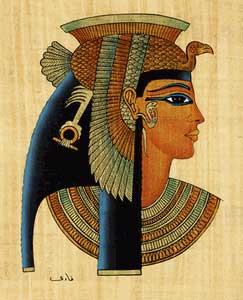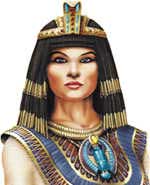Cleopatra and mysterious hairstyles
 Egyptian queen Cleopatra used different hairstyles in a calculated way to honor her position and power.
Egyptian queen Cleopatra used different hairstyles in a calculated way to honor her position and power.
According to Diana Kleiner, author of the newly published book Cleopatra and Rome, the statues, other coins and illustrations of the queen show Cleopatra (69-30 BC) had at least 3 hairstyles. . The first type, named "travel", imitated the hair of the Greek queen Queen, whereby the hair was divided into curls and tied into a bun in the back.
Next is the "melon" - melon-like hair, and the third is the royal style with the traditional Egyptian queen's wig. This style is adorned by a round cobra of precious metal.
Cleopatra did not create any hairstyle, but she knew how to use it in every appropriate situation, Kleiner, professor of art history in Yale, USA, said.
" From the time of Ptolemy I (the king of Egypt), Ptolemaic queens questioned the hairstyle of the division of the fruit like a melon or pumpkin. Cleopatra also followed that tradition - she was a more classicist. Kleiner said, "Kleiner.
 But the reality shows that Cleopatra also uses many other hairstyles. When the queen was in her homeland, her goal was to look like a traditional Egyptian leader (because of the fact that she was Greek), and to legitimize the Ptolemy dynasty, she sought to associate it with Pharaoh era. Some ancient statues show that she wore a traditional Egyptian wig with a curled cobra. " This is the type of hair attached to Cleopatra's image that we often see today, " Kleiner said.
But the reality shows that Cleopatra also uses many other hairstyles. When the queen was in her homeland, her goal was to look like a traditional Egyptian leader (because of the fact that she was Greek), and to legitimize the Ptolemy dynasty, she sought to associate it with Pharaoh era. Some ancient statues show that she wore a traditional Egyptian wig with a curled cobra. " This is the type of hair attached to Cleopatra's image that we often see today, " Kleiner said.
This hairstyle is associated with the poisonous snake god Wadjyt, the sun god Ra and the goddess Hathor, so wearing this hairstyle proves that he is considered a god.
The Egyptian queen also often traveled a lot. She went on a luxury boat with the attendants taking care of the roots. In Rome, she wears a "travel" hairstyle when appearing in places where people can admire and talk at parties. At the same time, Kleiner realized that the "melon" head style appeared in Roman portraits, proving that Roman women admired her and imitated her style.

Both Roman leaders Octavian and Antony were fascinated by Cleopatra's beauty. Kleiner said that Octavia, Antony's wife, created a nodus hairstyle to compete with Cleopatra. The nodus type has a frontal curl like Cleopatra's famous cobra ornament. Nodus became popular in Rome in the year 30 BC, just before Cleopatra committed suicide at age 39.
Kleiner judged that Cleopatra was not quite traditionally beautiful, but her whole being showed an irresistible appeal.
" Her beauty does not necessarily make people look ecstatic, but her way of speaking has an irresistible appeal. Her look and her charming voice and her own personality, exude from her demeanor Where can it be, make her a charm, drug ".
MT ( Discovery )
- Cleopatra scientist
- The fate of the children of Queen Cleopatra
- Real story of the Egyptian queen Cleopatra
- Cleopatra - the most powerful woman of the ancient world
- Cleopatra committed suicide with poisonous snakes: Is it true or just a legend?
- Little is known about Cleopatra's queens
- Excavation of Cleopatra's property under the ocean
- Recreating the perfume of Queen Cleopatra 2,000 years ago
- Video: The beauty history of American men in the past century
- Cleopatra may die of drugs
- Doubt about the death of the beautiful Egyptian queen
- The temple is believed to be the tomb of Cleopatra and her lover
 Discovered an ancient centipede fossil 99 million years old
Discovered an ancient centipede fossil 99 million years old Discovered bat-like dinosaurs in China
Discovered bat-like dinosaurs in China Discovered a 200-year-old bronze cannon of the coast
Discovered a 200-year-old bronze cannon of the coast Discover 305 million-year-old spider fossils
Discover 305 million-year-old spider fossils Netizens debate because the most powerful queen in history had her skin color changed
Netizens debate because the most powerful queen in history had her skin color changed  Why is Egyptian Queen Cleopatra the most viewed on Wikipedia in 2022?
Why is Egyptian Queen Cleopatra the most viewed on Wikipedia in 2022?  Mystery of white stone statue wearing crown believed to be Queen Cleopatra
Mystery of white stone statue wearing crown believed to be Queen Cleopatra  The truth about Queen Cleopatra: Both beautiful and fluent in 8 languages
The truth about Queen Cleopatra: Both beautiful and fluent in 8 languages  The greatest historical mysteries never have a solution
The greatest historical mysteries never have a solution  The burial place of Queen Cleopatra and her lover are about to be revealed?
The burial place of Queen Cleopatra and her lover are about to be revealed? 